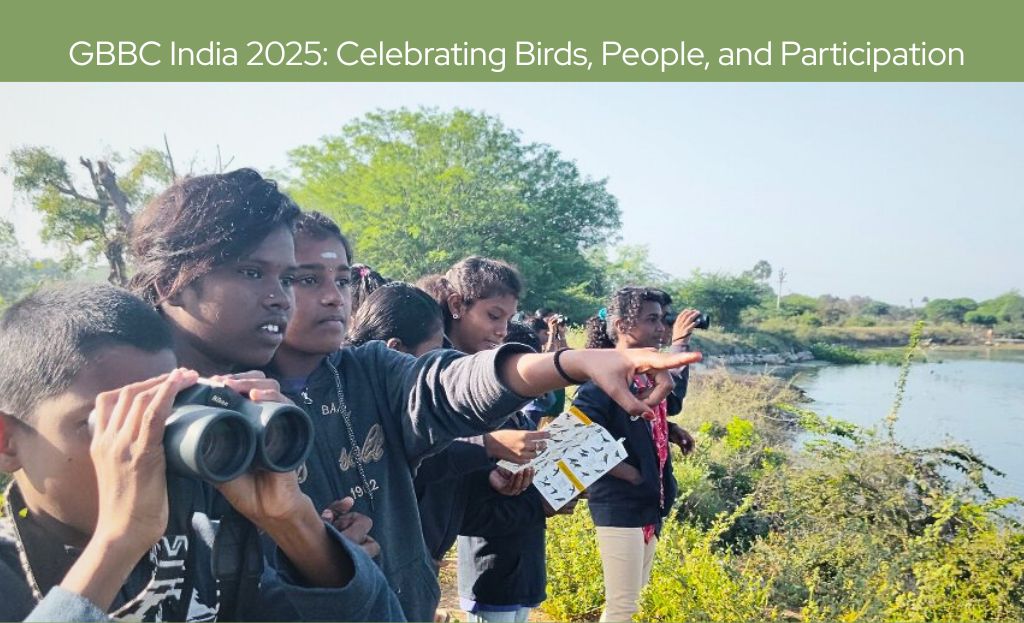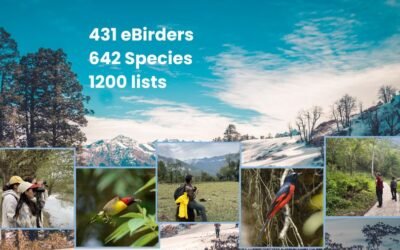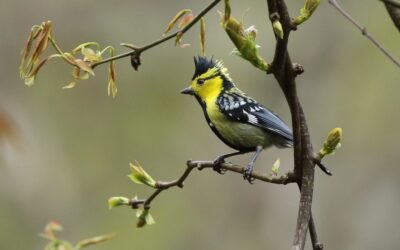Summary
Congratulations to all the birdwatchers and nature enthusiasts from across the country who made GBBC2025 a success! A special shout-out to all those who took this opportunity to conduct public bird walks and talks in their regions and campuses and introduced new people to the wonders of birds and nature.
Just like in previous years, the 13th edition of GBBC India was a resounding success. Between 14 to 17 February 2025, around 6,500 eBirders uploaded 66,155 checklists from over 24,000 hotspots and recorded 1,086 species—78.8% of the total number of species known to occur in the country!
- Click here to view list of eBirders from across India who participated in GBBC 2025!
- Campus Bird Count Results can be seen here.
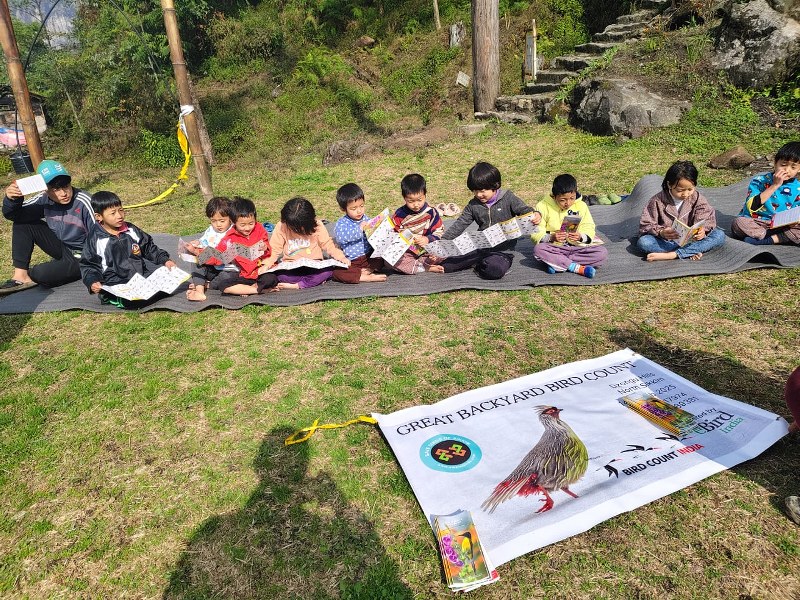
Fig 1: Young nature enthusiasts explore bird pocket guides during a GBBC 2025 session in Sikkim. Photo by Dibyendu Ash.
Table 1: Summary of GBBC 2025 Vs. GBBC 2024
| GBBC 2025 | GBBC 2024 | |
| eBirders | 6,500 | 5,334 |
| Lists | 66,155 | 58,276 |
| Species | 1,086 | 1,036 |
| Districts | 535 | 511 |
Note: The numbers presented in these results may slightly vary from the global results.
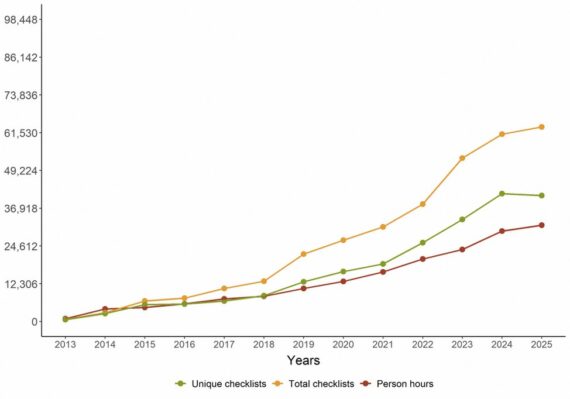
Fig 2: Growth in GBBC participation over the years: Unique checklists, total checklists, and person hours from 2013 to 2025
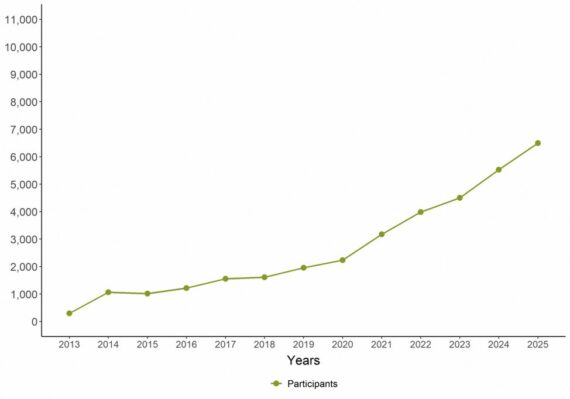
Fig 3: Increase in GBBC participation from 2013 to 2025, highlighting the steady growth in the number of participants.

Fig 4: Increase in district-level participation in GBBC from 2013 to 2025, showcasing a consistent rise in geographic spread.
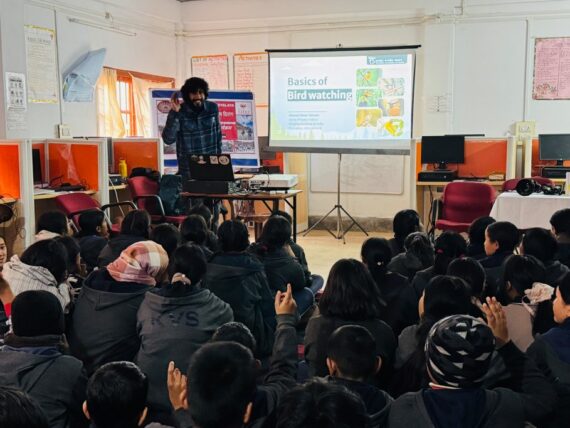
Fig 5: Students at Kendriya Vidyalaya School, Dirang, engage in an interactive session with Ahmed Omarr on birdwatching basics during the Great Backyard Bird Count (GBBC). Photo: Sri Prem Kumar (Faculty at KV Dirang)
GBBC Global
India stands out with an impressive 66,155 checklists, securing the 2nd rank globally in participation. In terms of species diversity, India ranks 4th, recording 1,086 species (highest number of species compared to previous GBBCs). These numbers showcase the enthusiasm and dedication of birdwatchers across the country in contributing to citizen science.
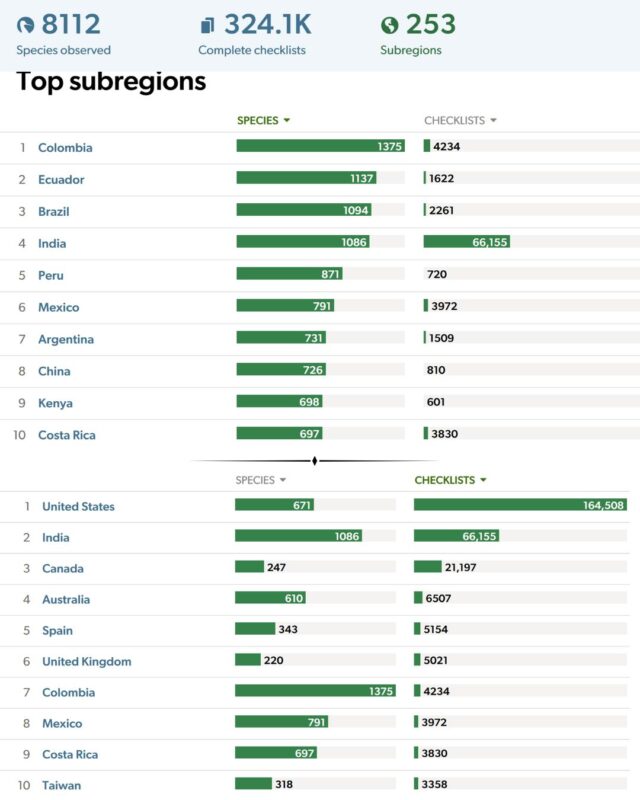
Fig 6: Screenshot from eBird.org highlights the top subregions in the Great Backyard Bird Count (GBBC) 2025 based on species observed and checklists uploaded.
Fig 7: Great Crested Grebe spotted during GBBC 2025 in Malda,West Bengal. Photo by Sayanta Basak.
GBBC India Highlights – A Celebration of Participation
The Great Backyard Bird Count (GBBC) 2025 built on the energy and enthusiasm of last year, with participation pouring in from all 36 states and union territories** of India. A remarkable 22 regions achieved complete district-level coverage, up from 16 in 2024. Newly added to this list were Chhattisgarh, Daman & Diu, Delhi, Ladakh, Meghalaya, and Tripura, reflecting the growing coordination and commitment of birding communities across the country. (See Table 3 for a full comparison.)
** While eBird lists 37 states and union territories, India officially recognizes 36.
This year’s GBBC also saw significant growth:
-
A 4.8% increase in species reported
-
A 13.6% rise in the number of eBird lists submitted
-
A 4.7% jump in district-level participation
-
Most notably, 2,500 new birders joined the effort on eBird in February 2025—twice the number from last February!
These numbers represent more than just data—they tell the story of a movement that continues to grow, connect people with nature, and bring birdwatchers together across regions, languages, and landscapes.
This achievement was made possible thanks to the efforts of GBBC coordinators, regional coordinators, birdwatchers, and partner organisations of the Bird Count India Collective, who undertook extensive preparations for this year’s event.
5,000+ New Birdwatchers Take Flight
This year, over 1,000 bird walks were registered as part of GBBC and the Campus Bird Count. These walks are estimated to have introduced more than 5,000 new nature enthusiasts to birdwatching!
Walks were led by GBBC coordinators, nature educators, experienced birders, and naturalists who generously volunteered their time and expertise. Some even took place inside military cantonments, thanks to special permissions. Meanwhile, around 270 campuses across India participated in the Campus Bird Count, bringing students and faculty together in the shared joy of birding.
A Surge in eBird Participation Across the Country
Many northeastern states saw a significant rise in the number of eBirders during this GBBC compared to the previous edition—Tripura recorded a 388% increase, Manipur 240%, Mizoram 120%, Sikkim 105%, and Meghalaya 57%. The Union Territories of Jammu & Kashmir and Ladakh also saw an increase in users—57% and 53% respectively. Among other states, Haryana recorded a 67% increase, and Madhya Pradesh saw a 59% rise in the number of eBirders.
In this map, each list contributed to GBBC is shown as a translucent circle. Deeper yellow indicates overlapping circles, which signals more lists from that location.
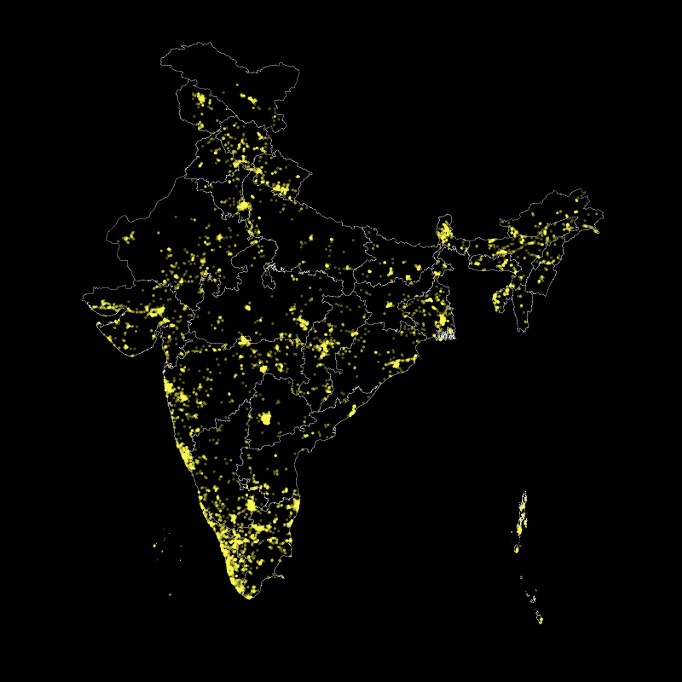
Fig 8: A visual representation of GBBC 2025 participation across India, where each yellow dot marks a submitted checklist. Brighter regions indicate greater birding activity.
Explore the interactive maps below to see the state wise and district-wise coverage for GBBC 2025. Zoom in and click on specific regions to view detailed summaries for each district.
Note: The below HTML maps are best viewed on a computer.
Fig 9: GBBC 2025 State/UT coverage. To see the GBBC summary for any state or union territory, zoom in and click on the specific region.
Fig 10: GBBC 2025 District coverage. To see the GBBC summary for any district, zoom in and click on the specific region.
What were the common species reported?
In every GBBC, we analyse the frequency** of the top five most reported species from seven broad regions of the country.
The Common Myna, which was previously among the top five most commonly reported species in at least five of the seven broad regions shown on the map, was surprisingly in top 5 only in the North and East, and absent from the rest this year. In contrast, the Red-vented Bulbul, previously among the top five only in the East and West, emerged as the most commonly reported species in the North, South, and Central regions this year. This shift made it the second most common species overall, replacing the Feral Pigeon from its earlier position in GBBC 2024.
**Frequency is the percentage of checklists reporting that species within a specified date range and region
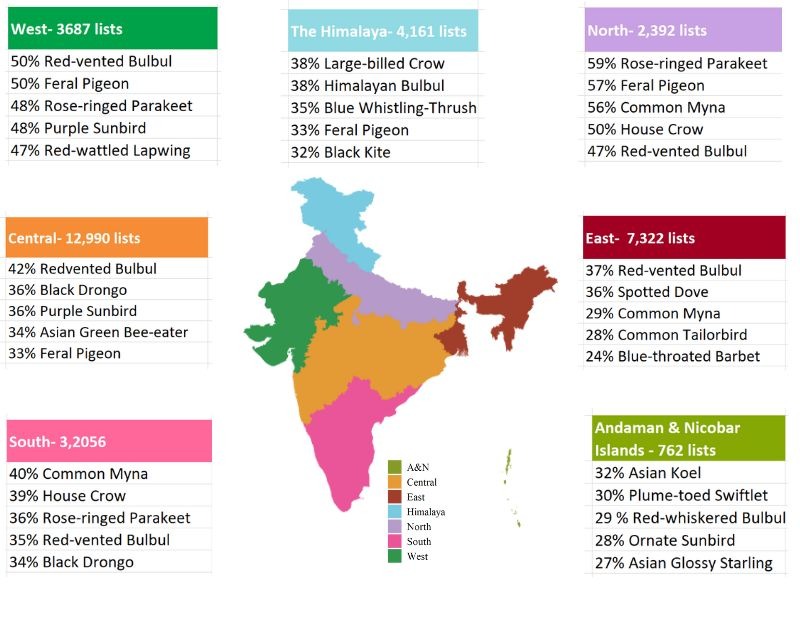
Fig 11: Top five most commonly reported bird species in India during GBBC 2025! From Red-vented Bulbuls and Feral Pigeons to Himalayan Bulbuls and Plume-toed Swifts, these birds were the most frequently recorded across different regions.
The Himalaya
Compared to the previous year, the top 5 most commonly reported species largely remain consistent, with a notable change: the Black Kite has entered the top 5, replacing the Cinereous Tit.
North
Interestingly, the Northern region shows a different pattern. The Black Kite did not appear in the top 5, with the Red-vented Bulbul taking a prominent position instead.
East
The East saw a minor shift, with the Common Tailorbird replacing the Black Drongo. Other species remain unchanged from the previous year.
Andaman & Nicobar Islands
A significant change occurred in this region, with three new species entering the top 5:
- Asian Koel
- Ornate Sunbird
- Asian Glossy Starling
Previously reported species like the White-throated Kingfisher, Andaman Coucal, and Common Myna did not make the top 5 this year.
South:
Most species remained consistent, with one key change: the Feral Pigeon was replaced by the Red-vented Bulbul.
Central:
The Common Myna was replaced by the Asian Green Bee-eater. Other species maintained their previous positions and reporting frequencies.
West:
The top 5 species set remained the same, with only slight variations in their reporting frequencies.
Fig 12: Plume-toed Swiftlet spotted during GBBC 2025, in South Andamans. Photo by: Shwetha Bharathi.
GBBC Stories from the field
Every bird walk has a story—and this year’s GBBC and Campus Bird Count were filled with moments of discovery, connection, and joy. From college campuses and forest trails to city parks and village fields, birders across India came together to celebrate birds and biodiversity. GBBC Stories have been moved here.
Acknowledgments
A big thank you to the volunteers who contributed to translations, designing, and reviewing multilingual posters and resources: Abhirami G S, Along Sangma, Angeline Mano M, Anuj Saikia, Abhirami G S, Aravind A M, Chai Eng Law, Chandrasekar Bandi, Chonseng Sangma, Christopher Lawlor, Dhaval Vargiya, Edison Basumatary, Emidacanee Dkhar, Ezra Rynjah, Gurpartap Singh, Hareesha A S, Jaydev Mandal, Kanad Baidya, Karishma Pradhan, Malyasri Bhattacharya, Manasa Venkat, Mehala Kumar, Misha Bansal, Nitin Raghav, Pravar Maurya, Premjit Elange, Ramesh Shenai, Ranjana Gosavi, Sahana M, Sumiti Saharan, Sohail Akbar, Sreekumar, Swetashree Purohit.
Stay Connected with Birds, Nature and Each Other
- The next GBBC/CBC will be on 13– 16 February, 2026
- For queries: Email skimmer@birdcount.in or WhatsApp +91 90081 96098
- For timely updates: Follow us on Instagram and join the Bird Count India Events & Updates WhatsApp Channel
- For direct news: Subscribe to receive regular birding updates and information from our team!
- For more information, you could also contact our Regional Coordinators listed here.
- If you want to start your birdwatching journey or show others the joy of birding, there’s no need to wait until the next GBBC! You can start birding right away and upload your checklists to eBird. First, download these two important free apps: the Merlin Bird ID App and the eBird App. You can find ‘How to’ videos and webinars on Bird Count India’s YouTube channel.
New to Birds? Start Here!
Subscribe to The Flock — An India-focused newsletter that brings the joy and wonder of birds and nature straight to your inbox.
Explore the Wonder of Birds — A free, multimedia, and mobile-friendly online course designed to inspire an appreciation of the beauty and significance of birds.
Additional Links:
- GBBC 2025 Prelim Results
- GBBC 2025 Participants
- GBBC Global Results
- Campus Bird Count 2025 Results
- Campus Bird Count 2025 Participants
- GBBC 2025 Stories from the field
Header Image: Curious young birders from Payir Nursery and Primary School spotting an Oriental Darter at Thenur Lake, Perambalur. Photo by: Angeline Mano

